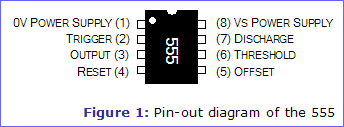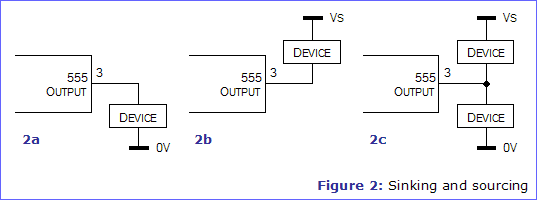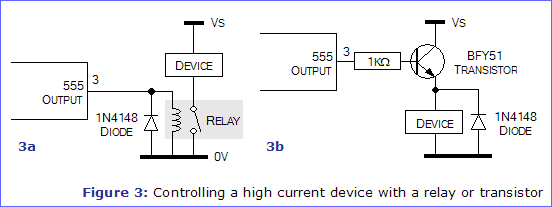|
The 555 Timer By Tim Surtell |
| |
||||
| |
Control your Meccano models (or anything else) from your Windows PC!
Take a look at my new MECControl project at meccontrol.com
The 555 Integrated Circuit (IC) is an easy to use timer that has many applications in Meccano modelling. It is widely used in electronic circuits and this popularity means it is also very cheap to purchase, typically costing around 30p.
Versions of the 555 are available for low current applications or use in extreme temperatures. A 'dual' version called the 556 is also available which includes two independent 555 ICs in one package.
| Datasheets | 555 Timer IC - PDF format (141kb) | |||||
| 556 Timer IC - PDF format (140kb) |
Output States
The 555 relies on both analogue and digital electronic techniques to perform its functions, but if we consider its output only, it can be thought of as a digital device.
The output of the 555 can be in one of two states at any time, which means it is a digital output. The first state is the 'low' state, which is the voltage 0V at the '-' (black) connection of your power supply. The second state is the 'high' state, which is the voltage Vs at the '+' (red) connection of your power supply. Vs is commonly 5V when using digital ICs. For convenience, these states are sometimes referred to by other names, and you will see that I frequently use the following names for them in my articles:
- Low is also known as 'space', or 'logic 0'. If a digital device is said to be 'off', its output is normally 0V.
- High is also known as 'mark', or 'logic 1'. If a digital device is said to be 'on', its output is normally Vs.
555 Circuits
In Electronics in Meccano, three of the most common 555 circuits will be introduced. Their names give you a clue as to their functions:
- The Astable Circuit produces a continuous train of pulses at any frequency you require. The name "astable" means "never stable" - the output of the circuit never stays stable in any of the two states.
- The Monostable Circuit produces one pulse of a set length in response to a trigger input such as a push button. The output of the circuit stays in the low state until there is a trigger input, hence the name "monostable" meaning "one stable state".
- The Bistable Circuit toggles between the states. Triggering one input sets the output to the low state, while triggering another input sets the output to the high state. The name "bistable" means "two stable states".
There are many ways to construct Astable, Monostable, and Bistable circuits, but using a 555 IC is one of the easiest.
The circuits above are covered in separate articles - the rest of this article will focus on the 555's pins and how its output can be used to control other devices.
| Related Articles | The 555 Astable Circuit | |||||
| The 555 Monostable Circuit | ||||||
| The 555 Bistable Circuit |
The Pins of the 555
First, we need to know what the 555 looks like. It has eight connections (called pins) to its plastic case, arranged as four on one side and four on the other, as shown in the pin-out diagram of figure 1. From this diagram, you can see that pin 1 is the pin on the bottom left when the IC is held horizontal with the writing the correct way up. The little notch in one side also helps to identify pin 1, as does the small white dot next to this pin.

The Power Supply
Pin 8 is where you connect the positive power supply (Vs) to the 555. This can be any voltage between 3V and 15V DC, but is commonly 5V DC when working with digital ICs. Pin 1 is the 0V connection to the power supply.
Trigger and Reset Inputs
Pin 2 is called the Trigger input as it is this input that sets the output to the high state. Pin 4 is called the Reset input as it is this input that resets the output to the low state. Both pins may be connected to push buttons to control the operation of the 555. Sometimes the Reset input is not used in a circuit, in which case it is connected directly to Vs so that unwanted resetting cannot occur.
Threshold and Discharge
Pins 6 and 7 (and sometimes the Trigger input, pin 2) are used to set up the timing aspect of the 555 IC. They are normally connected to a combination of resistors and a capacitor.
Offset
Pin 5 can be used to alter the timing aspect of the 555 IC in applications such as frequency modulation.
Output
Pin 3 is the digital output of the 555. It can be connected directly to the inputs of other digital ICs, or it can control other devices with the help of a few extra components.
Using the 555 Output
Sinking and Sourcing
In figure 2a, a device is shown connected between the Output pin 3 and 0V. When the Output goes high, current will flow through the device and switch it on. This is called 'sourcing' current because the current is sourced from the 555 and flows through the device to 0V.
In figure 2b, the device is shown connected between the Output pin 3 and Vs. When the Output goes low, current will flow through the device and switch it on. This is called 'sinking' current because the current is sourced from Vs and flows through the device and the 555 to 0V.
In figure 2c, sourcing and sinking are used together so that two devices can be alternately switched on and off.

The device(s) could be anything that can be switched on and off, such as LEDs, lamps, relays, motors or electromagnets. Unfortunately, these devices have to be connected to the Output in different ways because the Output of the 555 can only source or sink a current of up to 200mA. Make sure your power supply can provide enough current for both the device and the 555, otherwise the timing of the 555 will be affected.
LEDs
LEDs typically consume only 20mA, so they can be connected directly to the 555 Output via the usual current limiting resistor.
| Further Information | LEDs |
Lamps
Small low voltage lamps may be connected directly to the 555 Output, although it is best to switch them using a relay or transistor as shown in figure 3. You can of course control several lamps, and higher voltage lamps, using an appropriate relay.
Motors and Electromagnets
These must be switched via a relay or transistor as shown in figure 3 because of the high current they consume. Remember that the maximum current consumed by the relay coil itself is 200mA. Note that Vs need not be the same voltage as that used to power the 555 - it can be the voltage that the device requires, such as 12V for a motor, providing the limits of the relay or transistor are not exceeded.
| Further Information | Relays | |||||
| Transistors - This article is not yet available |
Notice the use of the diode in figure 3a. When the relay is switched off, it produces a back-emf that would normally damage the 555. The diode shorts out this back-emf so that no damage occurs. Make sure you put the diode in the correct way around, though, otherwise you will short out the power supply!
The diode is used again in figure 3b, but this time it is protecting the transistor from harm. The BFY51 transistor shown will be able to handle devices that consume up to 800mW.

 Shopping List
Shopping List
Here are the details of a few of the 555 and 556 IC range from Rapid Electronics, along with appropriate IC sockets for them. Also detailed are the components used in figure 3.
Part
DescriptionQuantity
RequiredRapid
CodeUnit
PriceTotal
Price14-pin Dual-in-line IC Socket 1 22-1721 £1.03 £1.03 1kΩ 0.25W Metal Film Resistor 1 62-3450 £2.66
(per pack of 100)£2.66 1N4148 Signal Diode 1 47-3416 £0.02 £0.02 8-pin Dual-in-line IC Socket 1 22-1720 £0.43 £0.43 BFY51 Medium Power NPN Transistor 1 81-0122 £0.91 £0.91 ICM7555IPA Low Power Timer IC 1 82-0774 £0.65 £0.65 NE555N Timer IC (Standard 555) 1 82-0336 £0.82 £0.82 NE556N Dual Timer IC 1 82-0344 £0.64 £0.64 TLC555CP Low Power Timer IC 1 82-0342 £0.79 £0.79 Grand Total £7.95
Order the above items from Rapid Electronics via our Circuits Shop and help support the Electronics in Meccano website, without affecting the price you pay! Just click on an item for information about it and/or to add it to your Rapid order.
Orders can also be placed by telephoning Rapid on 01206 751 166 or visiting their website at www.rapidonline.com. Prices quoted include VAT at 20%.
|
|
| Article Information |
Top of Page | Homepage | About | Search | Topics | Features | Circuits Shop | yourEiM |
© 1998 - 2025 Tim Surtell |